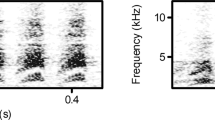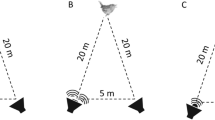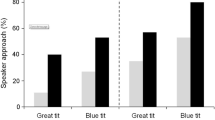Abstract
Animals emit predator-elicited calls in response to potential predation threats. These vocalizations induce a variety of anti-predator behaviors in conspecific receivers ranging from moving away from predators (alarm calls) to rallying conspecifics to fend them off (mobbing calls). While much is known about the immediate response to alarm calls, less is known about how mobbing calls influence subsequent antipredator decisions. Mobbing calls stimulate harassment of a potential predator. Therefore we predicted that hearing a mobbing call would make animals less likely to immediately flee an approaching threat. To study the potential effect of mobbing vocalizations on risk assessment, we primed common mynas (Acridotheres tristis) with a series of different stimuli and studied the variation in their subsequent decisions to flee an approaching human by quantifying flight initiation distance (FID). We found that although mynas increased their rate of locomotion after hearing mobbing calls, their subsequent decision to flee was not influenced. We also found that an individual’s propensity to move and look explained some variation in FID. This suggests that while mobbing calls do not influence subsequent decisions to flee, they do affect subsequent behavior.



Similar content being viewed by others
References
Abolins-Abols M, Ketterson ED (2017) Condition explains individual variation in mobbing behavior. Ethology 123:495–502
Adams JL, Camelio KW, Orique MJ, Blumstein DT (2006) Does information of predators influence general wariness? Behav Ecol Sociobiol 60:742–747
Baker J, Harvey KJ, French K (2014) Threats from introduced birds to native birds. Emu 114:1–12
Bates JH, Spotswood EN, Russell JC (2014) Foraging behaviour and habitat partitioning in sympatric invasive birds in French Polynesia. Notornis 61:35–42
Blumstein DT, Daniel JC (2007) Quantifying behavior the JWatcher Way. Sinauer Associates Inc, Sunderland
Blumstein DT, Fernández-Juricic E, LeDee O, Larsen E, Rodriguez-Prieto I, Zugmeyer C (2004) Avian risk assessment: effects of perching height and detectability. Ethology 110:273–285
Blumstein DT, Samia DSM, Stankowich T, Cooper WE Jr (2015) Best practice for the study of escape behavior. In: Escaping from predators: an integrative view of escape decisions. Cambridge University Press
Caro T (2005) Antipredator defenses in birds and mammals. The University of Chicago Press, Chicago
Center for Conservation Bioacoustics (2019) Raven Pro: Interactive Sound Analysis Software (Version 1.6) [Computer software]. Ithaca, NY: The Cornell Lab of Ornithology. https://ravensoundsoftware.com/. Accessed 1 Sept 2020
Cooper WE Jr, Frederick WG (2007) Optimal flight initiation distance. J Theor Biol 244:59–67
Counsilman JJ (1974) Waking and roosting behaviour of the Indian myna. Emu 74:135–148
Curio E, Ernst U, Vieth W (1978) The adaptive significance of avian mobbing: II. Cultural transmission of enemy recognition in blackbirds: effectiveness and some constraints. Z Tierpsychol 48:184–202
Dutour M, Léna JP, Lengagne T (2017) Mobbing calls: a signal transcending species boundaries. Anim Behav 131:3–11
Emmering QC, Schmidt KA (2011) Nesting songbirds assess spatial heterogeneity of predatory chipmunks by eavesdropping on their vocalizations. J Anim Ecol 80:1305–1312
Endler JA, Feder ME, Lauder GV (1986) Defense against predators. In: Predator-Prey Relationships Perspectives and Approaches from the Study of Lower Vertebrates. The University of Chicago Press, Chicago, pp 109–134
Fitzsimons J (2006) Anti-predator aggression in the common myna Acridotheres tristis. Aust Field Ornithol 23:202–205
Forsman JT, Mönkkönen M (2001) Responses by breeding birds to heterospecific song and mobbing call playbacks under varying predation risk. Anim Behav 62:1067–1073
Frid A, Dill LM (2002) Human-caused disturbance stimuli as a form of predation risk. Cons Ecol 6:11
Gill SA, Bierema AMK (2013) On the meaning of alarm calls: a review of functional reference in avian alarm calling. Ethology 119:449–461
Grarock K, Tidemann CR, Wood J, Lindenmayer DB (2012) Is it benign or is it a pariah? Empirical evidence for the impact of the common myna (Acridotheres tristis) on Australian birds. PLoS ONE 7:e40622
Griffin AS (2008) Social learning in Indian mynahs, Acridotheres tristis: the role of distress calls. Anim Behav 75:79–89
Griffin AS (2009) Temporal limitations on social learning of novel predators by Indian mynahs, Acridotheres tristis. Ethology 115:287–295
Hubbard L, King W, Vu A, Blumstein DT (2015) Heterospecific nonalarm vocalizations enhance risk assessment in common mynas. Behav Ecol 26:632–638
Hurd CR (1996) Interspecific attraction to the mobbing calls of black-capped chickadees (Parus atricapillus). Behav Ecol Sociobiol 38:287–292
Johnson FR, McNaughton EJ, Shelley CD, Blumstein DT (2003) Mechanisms of heterospecific recognition in avian mobbing calls. Aust J Zool 51:577–585
Kalb N, Randler C (2019) Behavioral responses to conspecific mobbing calls are predator-specific in great tits (Parus major). Ecol Evol 9:9207–9213
Kennedy RA, Evans CS, McDonald PG (2009) Individual distinctiveness in the mobbing call of a cooperative bird, the noisy miner Manorina melanocephala. J Avian Biol 40:481–490
Klump GM, Shalter MD (1984) Acoustic behaviour of birds and mammals in the predator context; I. Factors affecting the structure of alarm signals. II. The functional significance and evolution of alarm signals. Z Tierpsychol 66:189–226
Krippel J, Hyman J, Myers R (2013) Personality influences alarm calling behaviour in song sparrows. Behav 150:1147–1164
Kurvers RH, Van Oers K, Nolet BA, Jonker RM, Van Wieren SE, Prins HH, Ydenberg RC (2010) Personality predicts the use of social information. Ecol Lett 13:829–837
Lenth R (2020) Emmeans: Estimated Marginal Means, aka Least-Squares Means. R version 1. 4. 4. https://CRAN.R-project.org/package=emmeans. Accessed 1 Sept 2020
Lima SL, Dill LM (1990) Behavioral decisions made under the risk of predation: a review and prospectus. Can J Zool 68:619–640
Lind J, Jöngren F, Nilsson J, Alm DS, Strandmark A (2005) Information, predation risk and foraging decisions during mobbing in great tits Parus major. Ornis Fennica 82:89–96
Lüdecke D (2020) sjstats: statistical functions for regression models version 0.17.9 https://CRAN.R-project.org/package=sjstats. Accessed 1 Sept 2020
Magrath RD, Haff TM, Fallow PM, Radford AN (2015) Eavesdropping on heterospecific alarm calls: from mechanisms to consequences. BiolRev 90:560–586
Schmidt KA, Lee E, Ostfeld RS, Sieving K (2008) Eastern chipmunks increase their perception of predation risk in response to titmouse alarm calls. Behav Ecol 19:759–763
Stone E, Trost CH (1991) Predators, risks and context for mobbing and alarm calls in black-billed magpies. Anim Behav 41:633–638
Suzuki TN (2012) Referential mobbing calls elicit different predator-searching behaviours in Japanese great tits. Anim Behav 84:53–57
Templeton CN, Greene E, Davis K (2005) Allometry of alarm calls: black-capped chickadees encode information about predator size. Science 308:1934–1937
Webster M, Ward AJW, Hart PJB (2009) Individual boldness affects interspecific interactions in sticklebacks. Behav Ecol Sociobiol 63:511–520
Wolf M, Weissing FJ (2012) Animal personalities: consequences for ecology and evolution. Trends Ecol Evol 27:452–461
Ydenberg RC, Dill LM (1986) The economics of fleeing from predators. Adv Study Behav 16:229–249
Yee J, Lee J, Desowitz A, Blumstein DT (2013) The costs of conspecifics: are social distractions or environmental distractions more salient? Ethology 119:480–488
Acknowledgements
We thank the UCLA Department of Ecology and Evolutionary Biology for partial support. We thank Andrea S. Griffin for insights about myna vocalizations and for sharing an exemplar. We also thank Dana Williams for her help with data analysis, and Dana and two anonymous reviewers for comments on previous versions.
Author information
Authors and Affiliations
Corresponding author
Ethics declarations
Conflict of interest
The authors declare that they have no conflict of interest.
Ethical approval
Research was conducted under permits issued by the Government of French Polynesia (permit approved on 21 November 2019). Common mynas were studied under University of California Los Angeles (UCLA) IACUC Protocol 2001-147-62B (4 November 2019).
Additional information
Publisher's Note
Springer Nature remains neutral with regard to jurisdictional claims in published maps and institutional affiliations.
Electronic supplementary material
Below is the link to the electronic supplementary material.
About this article
Cite this article
Condon, T., Hakim, A., Moran, A.B.Z. et al. The effect of mobbing vocalizations on risk perception in common mynas (Acridotheres tristis). J Ethol 39, 89–96 (2021). https://doi.org/10.1007/s10164-020-00677-9
Received:
Accepted:
Published:
Issue Date:
DOI: https://doi.org/10.1007/s10164-020-00677-9




